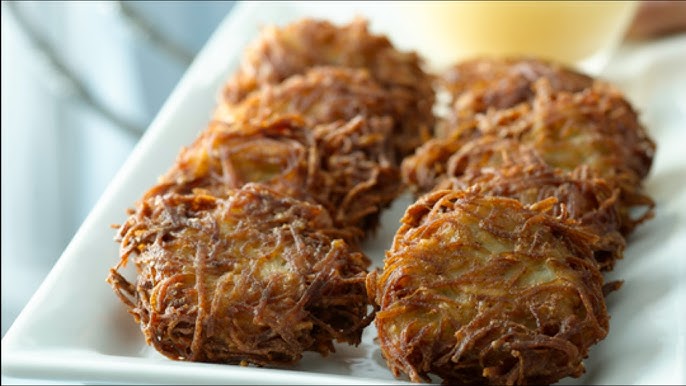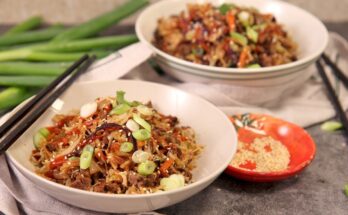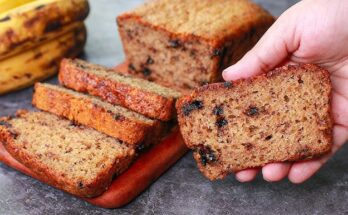Potato Latkes Recipe: Potato latkes are one of those comfort foods that hold a cherished place in many hearts—and kitchens—especially during Hanukkah. But their appeal goes far beyond any single holiday. These golden, crispy delights are essentially fried potato pancakes, known for their crunchy exterior and soft, savory inside. Whether you’re celebrating with family or just in the mood for something crispy and satisfying, latkes deliver on flavor and nostalgia.
Latkes are rooted deeply in Ashkenazi Jewish tradition. Historically, they were made using curd cheese, but over time, potatoes became the go-to base—largely due to their availability and affordability. In Eastern European households, they became a staple, not just during holidays but any time a hearty dish was needed. Today, you’ll find them across cultures, reinvented in countless ways but always honoring their delicious roots.
Making latkes is a tradition for many, passed down through generations. Each bite is a reminder of gatherings around the table, laughter, and the irresistible aroma of something wonderful frying on the stove. But beyond tradition, they’re just plain good. So let’s walk through how to make them perfectly—crispy, golden, and utterly addictive.
Ingredients Needed for Traditional Potato Latkes
The secret to perfect potato latkes starts with the right ingredients. While simple, each one plays a crucial role in texture and taste. Here’s your shopping list:
Main Ingredients:
- Russet potatoes (4 large or about 2 lbs) – These are high in starch and low in moisture, making them ideal for crisping up.
- Yellow onion (1 medium) – Adds depth of flavor and a bit of sweetness once cooked.
- Eggs (2 large) – They bind everything together.
- All-purpose flour (1/4 cup) – Helps hold the latkes’ shape.
- Salt (1 to 1.5 tsp) – Essential for flavor.
- Ground black pepper (1/2 tsp) – For a mild kick.
- Oil for frying (vegetable or canola oil) – You’ll need about 1/2 inch depth in your pan.
Optional Add-ins for Flavor:
- Garlic powder or minced garlic – For a savory twist.
- Chopped chives or parsley – Brightens up the flavor.
- Grated carrots or zucchini – For color and a hint of sweetness.
These ingredients form the heart of your latke recipe. The great thing about latkes is their flexibility. Once you’ve nailed the base, you can start experimenting with extras. But let’s start with the classic approach, which always hits the mark.
Tools You’ll Need
Before we dive into the actual cooking, make sure your kitchen is armed and ready. You don’t need anything fancy, but having the right tools will make your latke-making experience smoother and more enjoyable.
Basic Kitchen Tools:
- Box grater or food processor with a grating attachment – For shredding potatoes and onions.
- Large mixing bowls – One for the potato-onion mix, another for draining.
- Cheesecloth or a clean kitchen towel – To wring out moisture from the potatoes.
- Heavy-bottomed skillet or frying pan – Cast iron or non-stick pans are ideal.
- Slotted spatula – For flipping and draining oil.
- Paper towels – To drain excess oil after frying.
Helpful Extras for Efficiency:
- Colander – To help with draining.
- Thermometer – To monitor oil temperature (optional, but helpful).
- Cooling rack – Keeps latkes crisp after frying.
With these tools in hand, you’re all set to move on to the cooking process. Each tool contributes to either efficiency or a better final product—so don’t skip over these essentials!
Step-by-Step Guide to Making Potato Latkes
Ready to dive into the crispy goodness? Here’s how to make traditional potato latkes from scratch, one step at a time.
Step 1: Prepping the Potatoes and Onions
Start by peeling your potatoes. Once peeled, immediately grate them using the large holes on your box grater or food processor. Do the same with the onion. You want the pieces to be small enough to cook through, but not mushy.
Pro tip: Work quickly here. Potatoes oxidize fast, and you don’t want them turning grey. If needed, submerge them in water temporarily—just remember to drain well before the next step.
This is the foundation of your latke mixture. The goal is an even, coarse shred that holds up during frying. If you like a little more bite in your latkes, go for a coarser grate. Want them more delicate? Grate finer, but prepare to manage more moisture.
Step 2: Draining and Removing Excess Moisture
Here’s the step that separates good latkes from soggy ones. Once you’ve shredded your potatoes and onions, place the mix in a cheesecloth or clean towel and squeeze. And I mean really squeeze. Get out as much water as humanly possible.
You’ll be surprised how much liquid comes out. Removing this moisture is critical for achieving that beautiful, crisp exterior. Some pros even let the mix sit in a colander for 10 minutes, then squeeze again. You want dry-ish shreds, not a wet mess.
Next, let the liquid sit in a bowl for a few minutes—then pour off the water and keep the starch that settles at the bottom. That stuff helps bind your batter naturally.
Step 3: Mixing Ingredients for the Latke Batter
Now that your potato and onion mixture is ready and drained, it’s time to bring everything together into a cohesive batter. This step is where all those simple ingredients start to shine.
In a large mixing bowl, add your dry potato-onion mix. Next, crack in the eggs. These will help bind everything together so your latkes don’t fall apart while cooking. Sprinkle in your flour (or matzo meal if you’re going traditional), salt, and pepper. If you’re adding extras like garlic, herbs, or grated veggies, toss them in now too.
Using a spoon—or better yet, your hands—mix until everything is evenly combined. The batter should be moist but not wet, and you should be able to form a small patty that holds its shape. If it’s too loose, add a bit more flour. Too dry? A splash of water or an extra egg can help.
A common rookie mistake is overmixing. You’re not making a cake here. A gentle but thorough mix is all you need to get that rustic texture and bold flavor.
Step 4: Shaping and Frying the Latkes
Time for the fun (and slightly messy) part—frying! Heat a large skillet over medium-high heat and add about 1/4 to 1/2 inch of oil. You want enough to shallow-fry, not deep-fry. Wait until the oil is hot but not smoking—around 350°F is ideal.
Using your hands or a spoon, scoop out a portion of the latke batter and gently flatten it into a round patty. Carefully place it in the hot oil. Don’t overcrowd the pan—leave space so each latke can fry evenly and get crispy all over.
Fry for about 3–5 minutes per side, or until they’re golden brown and crisp. Flip carefully using a slotted spatula. Once both sides are perfectly fried, transfer to a paper towel-lined plate or a wire rack to drain excess oil.
Keep the cooked latkes warm in a low oven (around 200°F) while you finish frying the rest. This helps maintain crispness and ensures everyone gets to enjoy them hot.
Frying can be intimidating, but don’t worry. As long as your oil is hot enough and you don’t overload the pan, you’ll end up with golden beauties that are crunchy on the outside and tender on the inside.
Step 5: Serving Your Perfect Crispy Latkes
You’ve made it to the finish line! Now comes the best part—eating. Potato latkes are incredibly versatile, and how you serve them depends on your mood and tradition.
Classic Options:
- Applesauce – Sweet and tangy, a perfect contrast to the rich, savory latke.
- Sour cream – Cool and creamy, this is the go-to topping for many latke lovers.
- Chives or scallions – A fresh pop of green flavor on top.
Creative Twists:
- Smoked salmon and crème fraîche – Think upscale brunch.
- Poached egg with hot sauce – A new take on breakfast.
- Guacamole and salsa – Fusion meets tradition.
Arrange them on a platter, pile on your favorite toppings, and watch them disappear. They’re best enjoyed hot and fresh, but trust me, no one will complain even if they cool down a bit.
Potato latkes are more than just food—they’re a memory, a tradition, and a downright treat. Whether it’s your first time making them or your fiftieth, each batch is an opportunity to perfect your method and enjoy something truly satisfying.
Tips for the Best Potato Latkes Every Time
Even the most experienced home cooks can mess up a batch of latkes. But with a few pro tips and tricks, you’ll be turning out golden, crispy, restaurant-worthy latkes every single time. Let’s break down what makes or breaks this beloved dish.
Common Mistakes to Avoid:
- Not draining the potatoes properly – This is the #1 reason latkes turn out soggy. You must squeeze out every bit of moisture. Think of it like wringing out a wet rag—don’t hold back!
- Using the wrong kind of potatoes – Waxy potatoes like red or Yukon Gold have too much moisture and not enough starch. Russets are your best friend here because they’re dry and starchy, which leads to crispy perfection.
- Overcrowding the pan – If your pan is too full, the oil temperature drops and your latkes steam instead of fry. Give them room to crisp!
- Flipping too soon – Let them develop a solid crust before turning. If they’re sticking to the pan, they’re not ready to flip.
- Oil not hot enough – Lukewarm oil = greasy, soggy latkes. Hot oil = crispy, golden goodness. Keep it around 350°F.
Expert Techniques:
- Use a food processor – It’s faster, more consistent, and your knuckles will thank you.
- Add a pinch of baking powder – For extra fluffiness on the inside without compromising the crisp.
- Preheat your oil properly – Drop in a shred of potato—if it sizzles immediately, you’re good to go.
- Let the starch settle – After squeezing the potatoes, save that white sediment at the bottom of the bowl. It helps bind everything naturally.
- Keep a wire rack handy – Place fried latkes on a cooling rack set over a baking sheet. This keeps them crisp while you fry the rest.
With these tips, you’re not just making latkes—you’re mastering them. Like any great dish, it’s all in the technique. Once you lock it down, it’s smooth (and crispy) sailing.
Serving Suggestions
Latkes are amazing on their own, but what you serve with them can take things to the next level. Whether you want to keep it traditional or get creative, there’s a perfect pairing out there.
Classic Toppings:
- Applesauce – The sweetness balances out the savory richness of the fried potato. This pairing is a Hanukkah staple and a fan favorite.
- Sour cream – The creamy tanginess is a refreshing contrast to the crispy edges.
- Fresh herbs – Chopped parsley, dill, or chives add a pop of color and flavor.
Creative Twists:
- Avocado and salsa – Turn your latkes into a cross-cultural snack. It’s like Hanukkah met Taco Tuesday.
- Lox and cream cheese – Think of it as a bagel upgrade. Add capers and red onion for the full experience.
- Fried egg and hot sauce – Stack a sunny-side-up egg on your latke and drizzle with sriracha or your favorite hot sauce for a bold brunch dish.
- Pulled pork or brisket – For a hearty, meaty meal, top your latkes with shredded BBQ meat and slaw.
- Cranberry sauce – Especially great around the holidays. Sweet, tart, and vibrant.
You can also use latkes as a base for other dishes. Think of them as crispy potato canvases. Want a mini appetizer? Make smaller latkes and top them with a dollop of fancy toppings for a party-ready snack.
There’s no wrong way to serve a latke—only delicious options.
Storing and Reheating Latkes
Let’s be honest—leftover latkes don’t usually last long. But if you do happen to make extra (or intentionally double the batch), storing and reheating them the right way can keep them just as satisfying the next day.
Storing Tips:
- Refrigeration – Let your latkes cool completely, then store them in an airtight container lined with paper towels. The towels help absorb excess oil and moisture.
- Separation is key – Place parchment or wax paper between layers to prevent sticking.
- Shelf life – Latkes are best eaten within 2-3 days of making.
Freezing Instructions:
- Freeze individually – Lay cooked latkes in a single layer on a baking sheet and freeze until solid. Then transfer to a zip-top bag or airtight container.
- Label and date – Trust us, three months from now you’ll want to know what that bag of golden goodness is.
- Use within 1-2 months – They’re still safe beyond that, but the texture may suffer.
Reheating Tips:
- Oven method (recommended) – Preheat oven to 375°F. Place latkes on a wire rack over a baking sheet and heat for 10–15 minutes. They’ll come out crisp, almost as good as fresh.
- Skillet method – Reheat in a dry pan over medium heat for a few minutes on each side.
- Avoid the microwave – It makes them soggy, and nobody wants a limp latke.
With the right storage and reheating, you can enjoy latkes anytime without sacrificing that all-important crunch.
Healthier Alternatives
Love the idea of latkes but trying to keep things a bit lighter? You’re not alone. While traditional latkes are undeniably delicious, they’re also deep-fried, starchy, and rich. Thankfully, there are several healthier ways to enjoy this beloved dish without compromising on flavor or texture.
Baking Instead of Frying:
One of the easiest swaps is to bake your latkes rather than fry them in oil. It cuts down significantly on fat and calories but can still deliver that satisfying crisp.
How to do it:
- Preheat your oven to 425°F.
- Line a baking sheet with parchment paper or lightly grease it.
- Form your latkes and place them on the sheet, then lightly brush the tops with oil.
- Bake for 15–20 minutes on each side or until golden and crispy.
Baked latkes won’t have the exact same deep crunch as fried ones, but they still come out delicious—especially with a hot oven and just enough oil to crisp up the edges.
Air Fryer Latkes:
The air fryer is a game-changer for crispy foods without the mess of deep frying.
Steps:
- Preheat your air fryer to 375°F.
- Spray the basket with oil, place latkes in a single layer.
- Spray the tops of the latkes lightly with oil.
- Cook for 8–10 minutes per side or until golden brown and crispy.
You’ll be amazed at how close the texture is to fried, with a fraction of the oil.
Ingredient Substitutions:
Want to sneak in some extra nutrients or reduce carbs? Try these swaps:
- Sweet potatoes – Add natural sweetness and a boost of Vitamin A.
- Zucchini or carrots – Great for moisture and color. Just be sure to squeeze out all the liquid.
- Cauliflower – Lower in carbs and surprisingly satisfying.
- Whole wheat flour or almond flour – More fiber, less refined.
Also, try skipping the eggs and using a flaxseed or chia egg replacement to make vegan latkes. Combine 1 tablespoon ground flaxseed with 2.5 tablespoons water, let it sit, and you’ve got a perfect plant-based binder.
Going healthy doesn’t mean sacrificing flavor. These alternatives can open up a whole new world of latke possibilities while keeping things better for your body.
FAQs about Potato Latkes Recipe
1. Can I make latkes ahead of time?
Yes! You can fry them ahead of time and reheat them in the oven at 375°F for about 10 minutes to crisp them up again. Just store them in the fridge in an airtight container.
2. What’s the best oil for frying latkes?
Use oils with a high smoke point like vegetable oil, canola oil, or sunflower oil. Avoid olive oil—it can burn at high temperatures and affect the flavor.
3. How do I prevent soggy latkes?
Make sure to squeeze all the moisture from your potatoes, use russet potatoes, and fry at the correct temperature (about 350°F). Also, don’t overcrowd the pan.
4. Can I freeze potato latkes?
Absolutely. Lay them in a single layer to freeze, then transfer to a freezer bag. Reheat in a hot oven for best results.
5. What are the best potatoes to use?
Russet potatoes are the top choice thanks to their high starch content and low moisture. They fry up super crispy and hold their shape well.
Conclusion
There’s something timeless and irresistible about potato latkes. Whether you’re making them for a holiday gathering, a family dinner, or just because you’re craving that crispy, golden perfection, latkes bring joy to the table. The best part? They’re easier to make than you think—especially once you’ve got the steps and tips down.
From selecting the right potatoes and squeezing out the moisture to frying them up crisp or baking a healthier version, every choice adds to the final result. You can go traditional with sour cream and applesauce or get creative with modern toppings like avocado and smoked salmon. And don’t forget—you can make extra, store them right, and enjoy them later.
So get your ingredients, grab a skillet, and start shredding. Whether you’re honoring tradition or putting your own spin on things, one thing is certain: potato latkes are always worth the effort.



